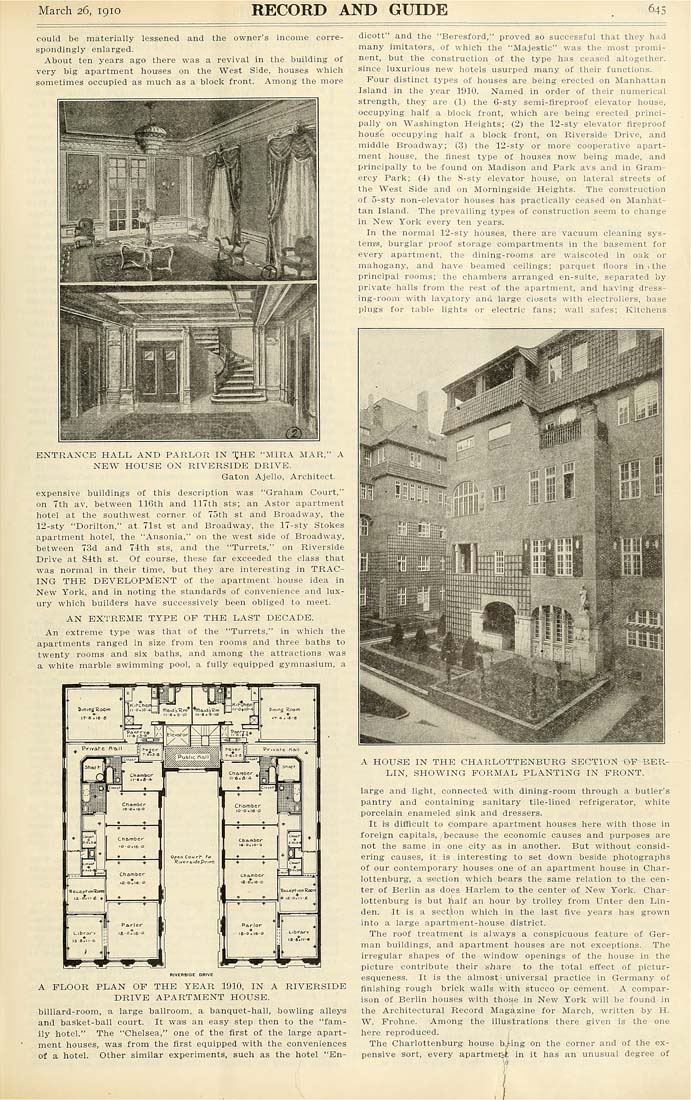Columbia University Libraries Digital Collections: The Real Estate Record
Use your browser's Print function to print these pages.
Real estate record and builders' guide: v. 85, no. 2193: March 26, 1910

Text version:
Please note: this text may be incomplete. For more information about this OCR, view About OCR text.
March 26, igio RECORD AND GUTDE 645 could be materially lessened and the owner's income corre¬ spondingly enlarged. About ten years ago there was a revival in the building of very big apartment houses on the West Side, houses which sometimes occupied as much as a block front. Among the more ENTRANCE HALL AND PARLOR IN XWE "MIRA MAR," A NEW HOUSE ON RIVERSIDE DRIVE. Gaton Ajello, Architect. expensive buildings of this description was "Graham Court," on 7th av, between 116th and 117th sts; an Astor apartment hotel at the southwest corner of 7oth st and Broadway, the 12-sty "Dorilton," at 71st 'St and Broadway, the 17-sty Stokes apartment hotel, the "Ansonia," on the west side of Broadway, between 73d and 74th sts, and the "Turrets," on Riverside Drive at 84th st. Of course, these far exceeded the class tbat was normal in their time, but they are interesting in TRAC¬ ING THE DEVELOPMENT of the apartment house idea in New York, and in noting the standards of convenience and lux¬ ury which builders have successively been obliged to meet. AN EXTREME TYPE OF THB LAST DECADE. An extreme type was that of the "Turrets," in which the apartments ranged in size from ten rooms and three baths to twenty rooms and six baths, and among the attractions was a white marble swimming pool, a fully equipped gymnasium, a A FLOOR PLAN OF THE YEAR 1010, IN A RIVERSIDE DRIVE APARTMENT HOUSE, billiard-room, a large ballroom, a banquet-hall, bowling alleys and basket-ball court. It was an easy step then to the "fam¬ ily hotel." The "Chelsea," one of the first of the large apart¬ ment houses, was from the flrst equipped with the conveniences of a hotel. Other similar experiments, such as the hotel "En¬ dicott" and the "Beresford," proved so successful that they had many imitators, of which the "Majestic" was the most promi¬ nent, but the construction of tlie type has ceased altogether, since luxurious new hotels usurped many of their functions. -Four distinct types of houses are being erected on Manhattan Island in the year 1910. Named in order of their numerical strength, they are (1) the 6-sty semi-fireproof elevator liouse, occupying half a block front, which are being erected princi¬ pally on Washington Heights; (2> the 12-sty elevator fireproof house occupying half a block front, on Riverside Drive, and middle Broadway; (3) the 12-sty or more cooperative apart¬ ment house, the finest type of houses now being made, and principally to be found on Madison and Park avs and in Gram¬ ercy Park; <4) the S-sty elevator house, on lateral streets of the West Side and on Morningside Heights. The construction of (5-sty non-elevator houses has practically ceased on Manhat¬ tan Island. Tiie prevailing types of construction seem to change in New York every ten years. In the normal 12-sty houses, there are vacuum cleaning sys¬ tems, burglar proof storage compartments in the basement for every apartment, the dining-rooms are waiscoted in oak or mahogany, and have beamed ceilings; parciuet floors in ithe principal rooms; the cbamber-s arranged en-suite, separated by private lialls from the rest of tbe apartment, and having dress¬ ing-room with lavatory and large closets with electroliers, base plugs for table lights or electric fans; wall safes; Kitchens A HOUSE IN THE CHARLOTTENBURG SECTION OF BER¬ LIN. SHOWING FORMALJ-LANTING IN FRONT. large and light, connected %ith dining-room through a butler's pantry and containing sanitary tile-lined refrigerator, white porcelain enameled sink and dressers. It Is difficult to compare apartment houses here with those in foreign capitals, .because the economic causes and purposes are not the same in one city as in another. But without consid¬ ering causes, it is interesting to set down beside photographs of our contemporary houses one of an apartment house in Char- lottenburg, a section which bears the same relation to the cen¬ ter of Berlin as doea Harlem to the center of New York. Char- lottenburg is but l^alf an hour by trolley from Unter den Lin¬ den. It is a sect.ion which in the last flve years has grown into a large apartment-house district. The roof treatment is always a conspicuous feature of Ger¬ man buildings, and apartment houses are not exceptions. The irregular shapes of the window openings of the house in the picture contribute their share to the total effect of pictur- esqueness. It is the almost ■ universal practice in Germany of flnishing rough brick walls with stucco or cement. A compar¬ ison of Berlin houses with thoi^e in New York will be found in the Architectural Record Magazine for March, written hy H. W. Frohne. Among the illustrations there given is the one liere reproduced. , The Charlottenburg house bj;ing on the corner and of the ex¬ pensive sort, every apartmeijt in it has an unusual degree of